SPUN STEAL VS CAST IRON VS ALUMINUM DUTCH OVENS
The origins of the Dutch oven come from the Netherlands (as you might expect from something with the word “Dutch” in its name) probably dating to the 17th century. For hundreds of years, the most valued cookware was made of expensive materials such as copper and brass. For more common usage cast iron was popular and the standard for fire cooking.
As back woods travelers open fires, and the coal they produce, are excellent sources of heat for Camp oven cooking. Today there are many types of Dutch ovens from electrically controlled, cast and coated aluminum, enamel coated cast iron to simple cast iron and spun steel. The fancier home oven style Dutch ovens are not really appropriate for camping use and are best left in your household kitchen. The types most popular for outdoor fire cooking, commonly called camp ovens, are cast iron, cast aluminum and spun steel. Beside the finish the most significant difference between the home Dutch oven and the Camp oven is the lid. While Dutch oven lids are often domed and typically have drippers for self-basting, a camp oven's lid is thick, mostly flat, smooth-bottomed and has a ridge around the top edge. The massive lid helps maximize heat retention and allows you to put coals on top of the Camp oven for even cooking.
Camp ovens come in various sizes, often designated by the diameter of the pot (i.e. 10”, 12”, etc.) and are excellent for everything from stews, to whole chickens, meat roasts, soups, deserts (cakes, cobblers, puddings, etc.). In fact virtually anything you can cook in a convention home oven can be done over an open fire in a Camp oven.
The traditional cast iron Camp oven is a tried and true companion to outdoor chiefs while the newer spun steel and aluminum ovens have a number of advantages, and some differences to the traditional camp oven. The big advantages to spun steel and aluminum ovens, for overland travelers, are that they are lighter (about 1/3 the weight of a comparable cast iron oven), stronger, and less brittle than their cast iron counterparts, and will not crack or break if dropped. That said, they are much thinner than the cast iron option, and so don't retain heat as well, or offer as even heat distribution.
CAST IRON:
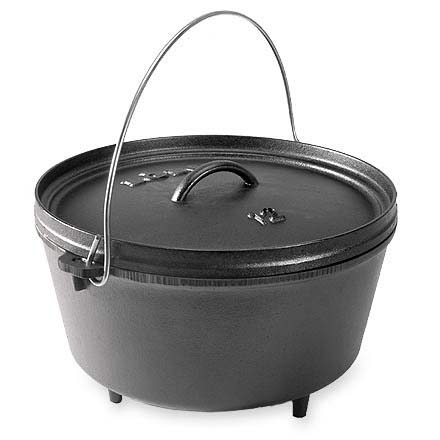
- Lodge Cast Iron Dutch Oven
- lodge DO.jpg (36.23 KiB) Viewed 941 times
Available from Amazon for about $80, order the Trivet separately (about $15, see below) and you’ll want a Lodge Lid Lifter (also available on Amazon) for about $15.
CAST IRON PROS:
• Exceptional heat retention; perfect for slow cooking
• Even heat distribution – easier to get the ‘oven’ effect from them and a touch easier to cook with for first-timers chasing the traditional camp-oven roast.
• Longevity – look after your oven, they’ll last a very long time.
CONS
• They’re a heavy bit of kit for what they are.
• If they do begin to rust, it can be hard to bring them back to a usable state. Although a good wire brush and some effort will usually restore all but the most badly rusted.
• They’re brittle. If you drop a cast iron oven, there’s a good chance it will crack which renders it just about useless.
SPUN STEEL
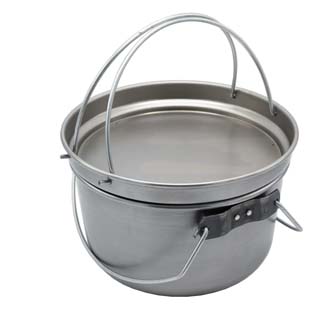
- Aussi - Dr. Livingston Spun Steel DO
- Dr-Livingston DO.jpg (26.87 KiB) Viewed 941 times
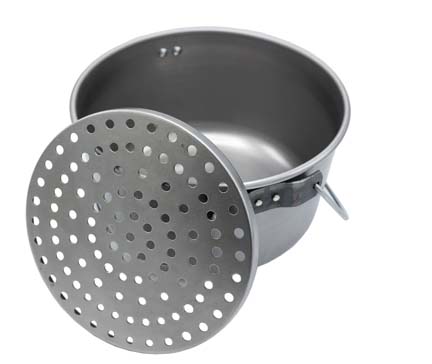
- Spun Steel Trivet
- Dr-Livingston with trivel.jpg (31.79 KiB) Viewed 941 times
The Dr. Livingstone's spun steel camp oven, also known as the Aussie Camp Oven can be used as a frypan, boiler, hanging pot and of course a camp oven. It has two solid wire handles on the pot and two on the lid to make it easy and stable to move, unlike some single wire systems which can be wobbly. Available from Mule Expedition Outfitters for about $65.
The spun steel camp oven is said to be an Australian adaption of the cast iron camp oven. Originally, drovers working on cattle stations in western Queensland used cast iron camp ovens which would break if they fell from their pack horses. A mild steel camp oven was created in response to this problem. The spun steel ovens are lighter, stronger, and less brittle than their cast iron counterparts, and will not crack or break if dropped. All advantageous to us back country overland travelers.
That said, spun steel is much thinner than the cast iron option, and so doesn’t retain heat as well, or offer as even heat distribution. When cooking with them, extra care must be taken to keep an eye on the amount of coals added at the base, more coals should be added to the top of the oven, to have the heat dissipate downwards, compared to a traditional cast iron oven. Most chiefs recommend about 70% of the coals on top and 30% under a spun steel oven.
SPUN STEEL PROS
• Lightweight – they’re usually a third of the weight of a cast iron camp oven
• Much more robust than their cast iron counterpart
• They heat up and begin cooking much quicker; so the lid can be used separately on a fire as a skillet or frying pan.
• Can be used easily on either coals or a gas cook top.
CONS
• They do not retain the heat as well or as evenly as cast iron, so more care is needed when cooking.
• Much harder to get a solid slow-cooked roast from spun steel. More practice is needed to keep an even temperature and get your roasts spot on but using a trivet helps.
ALUMINUM CAMP OVENS
There are many people who use aluminum pots, pans and skillets at home and there probably isn’t any good reason not to use them in the bush. Aluminum can be more fragile than spun steel but a good cast aluminum camp oven should be OK. Personally, I’ve never used one but they seem to have pretty much the same advantages, and disadvantages, as spun steel (i.e. heat easily, don’t hold heat as well as cast iron, can get hot spots, etc.). There is some controversy about using aluminum camp ovens and high heat or cooking acidic foods damaging coating and causing leaching of aluminum into the food. There is a ton of debate on this issue, with both sides saying they are right. And since I’m not a doctor or scientist of any kind, I’m not going to give you a definitive answer, as I doubt there really is one.
What I will do is provide you with the views of each side. Then I suggest you make a decision you are comfortable with.
First off, here is a problem with aluminum. It doesn’t react well with acidic foods. The acid causes the metal to leach into whatever you are cooking. So most cookware will have some sort of non-stick layer or it will be anodized.
Anodization is an electrochemical process that forms a layer over naturally occurring aluminum oxide which happens when aluminum is exposed to the air.
Having said all that, even if aluminum is coated with a nonstick layer or anodized, it will still leach a small amount of aluminum content in your food. According to the National Center for Biotechnology Information (NCBI), “Cooking in aluminum utensils often results in statistically significant, but relatively small, increases in aluminum content of food.”
In September 1985, the then-current issue of the Journal of Food Protection estimated that food that had been in contact with either aluminum pots or foil added an average of 3.5 mg of aluminum to the diet. However, most adults are already ingesting 7 to 9 mg of aluminum from food daily, not including the 3.5 mentioned above.
The bottom line is that if you do choose aluminum, anodized is probably your best option, but don’t cook acidic foods in it. And if your pots and pans are damaged in any way, get rid of them. Acidity and damage will increase the amount of leaching.
INTERNAL POT TRIVET
For any type of camp oven I recommend you buy an internal oven trivet (an 8-inch cast-iron designed for the inside of Dutch ovens 4 quarts (10”) or larger). Lodge iron trivets are available on Amazon for about $15. The Dr. Livingston spun steel camp oven comes with a trivet. The trivet raise meats, pies, and other foods off the pan bottom to help prevent scorching and make even heating much easier.
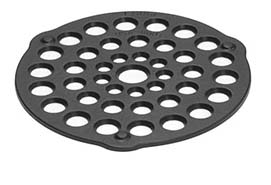
- Trivet insert
- trivet.jpg (29.51 KiB) Viewed 939 times
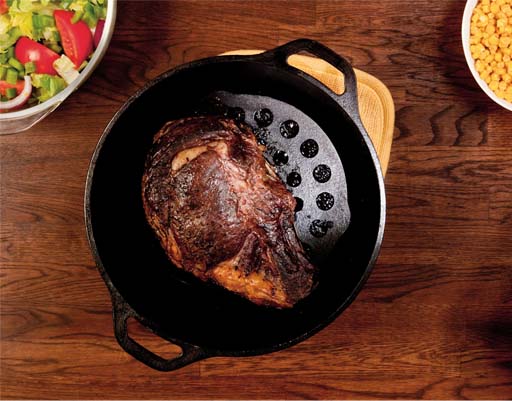
- Roast in cast iron do with trivet
- roast on trivet.jpg (64.05 KiB) Viewed 939 times
SUMMARY
I’ve used, and have, both cast iron and spun steel ovens and for outdoor travel recommend the spun steel. Cast iron has some appeal, and certainly is more traditional, but to save weight and provide a more robust pot for me the spun steel has the edge. As for aluminum I use an aluminum skillet and pots but prefer the spun steel camp oven. At the end of the day, the choice is yours. Do whatever you feel comfortable with.